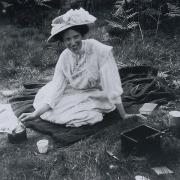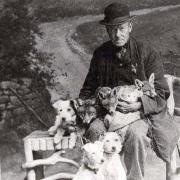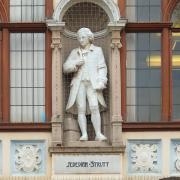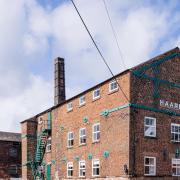Sixty years since the publication of secret agent 007’s first dare-devil adventure, the real-life romance between writer Ian Fleming and an Ashbourne debutante jumps straight off the pages of fiction
Had Muriel Joyce Wright lived in today’s streaming-rich world, it is little stretch of the imagination to picture her regularly posting on Instagram or TikTok.
Here she might be found modelling the latest high-end swimwear design in Monte Carlo. There could be shots too of her posing on a snowy European piste.
Or, closer to home, sitting confidently astride a polo pony; the fulfilment of another sporting passion.
Because, back in the 1930s, ‘Mu’ as her lover, the James Bond creator Ian Fleming, called her, lived life in the fast lane.
That the two were first attracted to one another, she at 26, he at 27, in the fashionable Austrian ski resort of Kitzbűhel, speaks volumes of the hedonistic world they occupied.
A world which, for Mu or ‘Moo’ as she’s also sometimes known, had its roots in the Derbyshire countryside.
Her story begins a few miles outside of Ashbourne, at Yeldersley Hall. This imposing Georgian residence set within rolling scenery was built around 1800 by Edmund Evans, a Derby banker and founder of Darley Abbey Mills.
Despite inheriting the Hall, Edmund’s daughter Elizabeth lived with husband John Harrison at nearby Snelston. For many decades, Yeldersley was rented out to wealthy tenants, including John’s descendants.
In the 1860s the Hall and its 700-plus acre estate was bought by Mu’s great-grandfather, the industrialist Francis Wright, who’d married Selina Fitzherbert of Tissington Hall lineage.
With business booming thanks to the Wright-owned Butterley Company having become the largest coal and iron works in the East Midlands – the original St Pancras Station was a major commission – Francis also left his mark by constructing Osmaston Manor and remodelling the village. A monument in Ashbourne’s Market Place, testament to the impact Francis made.
By the early 20th century it was his grandson Captain Henry Fitzherbert Wright, who’d not only joined the family business but chosen to live at Yeldersley Hall.
Another leading player within Derbyshire society, Henry was a county cricketer, served as a JP and council alderman, as well as becoming elected as an MP.
Unsurprisingly, Henry’s daughter Mu, born in 1909, the second youngest of his eight children, did not seek work, earning instead the family nickname ‘honeytop’, thanks to her head-turning looks and blond hair, as she followed the local Meynell Hunt.
Once described by Fleming as ‘too good to be true’, Mu was smitten for almost a decade by the man who, at the time they met, was a London stockbroker; his previous careers having included a short spell of military training and journalistic assignments for Reuters in Russia.
Although a visitor to Yeldersley Hall on several occasions, Fleming declined to return Mu’s devotion, reportedly continuing a playboy lifestyle.
‘There is little doubt he strung her along,’ observes his biographer Andrew Lycett in Ian Fleming The Man Who Created James Bond. ‘Her family weren’t happy about this, as was clear from the attitude of her brother.’
Fitzherbert Wright, an Old Etonian alongside Fleming, reputedly went as far as going to his former schoolmate’s London residence, armed with a horsewhip; the intended confrontation avoided, when he discovered the couple to be away together in Brighton.
It was Mu, though, who became the victim in a freak accident during World War Two.
After stepping-up to serve her country as an air raid warden in Belgravia, she later joined the WRENS as a high-octane motorcycle despatch rider; a role that saw this dashing figure ferrying messages between senior government departments.
However, awoken in her Eaton Terrace flat one spring day in 1944, a piece of masonry from a nearby bomb explosion flew through an open window hitting Mu on the head. The 34-year-old died instantly.
With the building left intact, it was the whimpering of her faithful dog Pushkin that prompted the tragic discovery.
Called upon to identify his lover, according to Andrew Lycett: ‘Ian was filled with remorse’. It’s said that afterwards, Fleming refused to visit restaurants they’d previously dined.
The grief extended into later life when, having retreated to Jamaica, Mu’s bracelet was kept on a keyring.
His biographer is open-minded about the extent to which the couple collaborated, whilst Fleming carried out wartime intelligence duties at the Admiralty.
‘Did she help him [Fleming] with spying? There’s no evidence of this, but when employed at the Foreign Office she [Muriel] did do a short course at Bletchley Park.’
It’s widely acknowledged however that after leaving the Admiralty to turn his hand to fiction writing, Fleming drew inspiration both from this world and his personal life.
The publication of Casino Royale in 1953 first introduced James Bond as the heart-stopping action hero, in a storyline packed with escapes, international espionage, and beautiful women.
Whilst in some quarters, the character of Vesper Lynd is thought to be based on Christine Granville, an acknowledged secret agent, Mu has also been suggested as his muse.
And, there’s every reason to suspect she’s immortalised as the fictional Contessa Teresa di Vicenzo, aka Teresa ‘Tracy’ Bond, of On Her Majesty’s Secret Service fame.
Published in 1963, Tracy becomes the second Mrs Bond whose unexpected death and its effect on 007, shines through the novel and the film adaptation starring Diana Rigg and George Lazenby.
Fleming wrote 12 Bond novels and two collections of short stories collections, spawning a blockbuster cinema franchise.
On the small screen, the bio-pic Fleming: The Man Who Would Be Bond sought to capture his real-life relationship with Muriel. Yet, intriguingly, she continues to remain largely beneath the radar.
Back in Derbyshire, a memorial plaque in Osmaston Church conveys the spirit of this English rose, in the citation: fearless and free.
Coincidentally, it was here Yeldersley Hall’s current owner Andrew Bailey and wife Catherine were married.
Meanwhile, renovations undertaken by Andrew, who bought the property in 1996, have revealed further insight into Mu’s upbringing.
‘It was a bit of a project for us, there was lots to do,’ he recalls. ‘Because you live in a place like this you get interested in its history. As I was scrapping away at some lining paper, I saw these lines with initials, which led me to work out the identities of who everybody was. That’s when I first found out about Muriel.’
This discovery of a children’s height chart from Christmas 1918 preserves, says Andrew, the gathering of ‘MJW’ and her siblings, as a moment in history.
‘The heyday of the house was probably at the time of our height chart. By the end of the war, the Butterley Company was doing well, which is when a lot of work was done to the Hall. And as it was Christmas, you can imagine the scene in the dining room with everyone there.’
Within the property’s side extension, thought to have been added by Mu’s father, the Fitzherbert Wright crest proudly adorns an Arts and Crafts fireplace.
Despite several changes in ownership since the Captain sold-up in 1947, there remain further examples of his decorative embellishments and the daily routines. From original William Morris wallpaper to a vintage children’s night nursery sign.
Outside, the former stable block houses a tack room beneath a Smith’s of Derby clock installed in 1911, recalling the family’s equestrian pursuits. It was, as Andrew points out, a way of life that set all the offspring on their future path.
‘They weren’t a high society family but quite aspirational regarding who they felt they should be marrying’ he says.
This led to Mu’s elder sister Margaret tying the knot with a Georgian prince. And, to her niece’s nuptials which saw Susan becoming the late mother of Sarah Ferguson, Duchess of York. In another twist of serendipity, Yeldersley Hall is today a successful wedding venue.
Muriel Wright may never have become betrothed to the man of her dreams yet, as more episodes in her life come to light, Ashbourne’s Bond girl is not forgotten.































